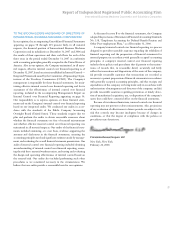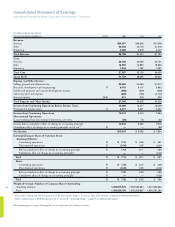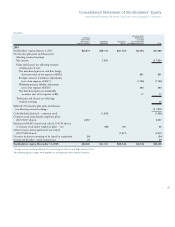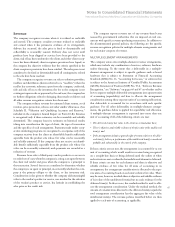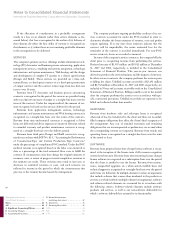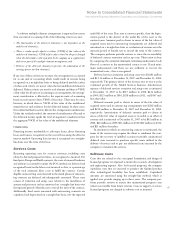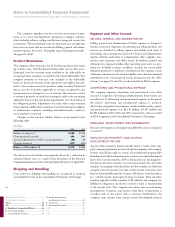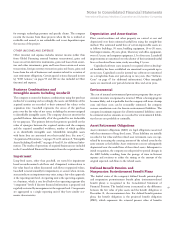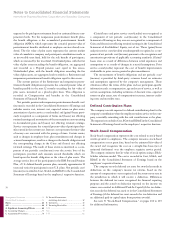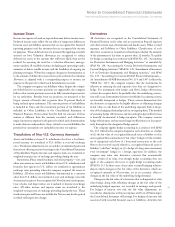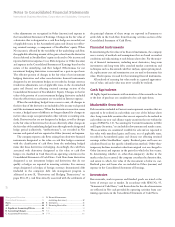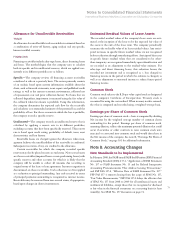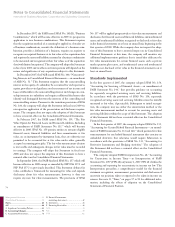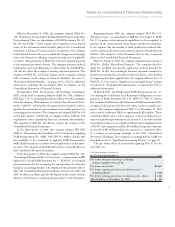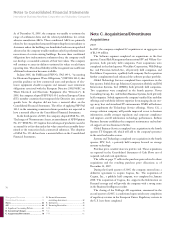IBM 2007 Annual Report Download - page 68
Download and view the complete annual report
Please find page 68 of the 2007 IBM annual report below. You can navigate through the pages in the report by either clicking on the pages listed below, or by using the keyword search tool below to find specific information within the annual report.
66
Notes to Consolidated Financial Statements
International Business Machines Corporation and Subsidiary Companies
Management Discussion ..................................14
Consolidated Statements ..................................58
Notes ........................................................... 64
A-F ............................................................. 64
A. Significant Accounting Policies ............ 64
B. Accounting Changes ...................................73
C. Acquisitions/Divestitures ............................76
D. Financial Instruments
(excluding derivatives).................................82
E. Inventories ...................................................83
F. Financing Receivables .................................83
G-M ..................................................................84
N-S ...................................................................94
T-W ................................................................102
If the allocation of consideration in a profitable arrangement
results in a loss on an element (other than service elements as dis-
cussed below), that loss is recognized at the earlier of (a) delivery of
that element, (b) when the first dollar of revenue is recognized on
that element, or (c) when there are no remaining profitable elements
in the arrangement to be delivered.
SERVICES
The company’s primary services offerings include information tech-
nology (IT) datacenter and business process outsourcing, application
management services, consulting and systems integration, technology
infrastructure and system maintenance, Web hosting and the design
and development of complex IT systems to a client’s specifications
(Design and Build). These services are provided on a time-and-
material basis, as a fixed-price contract or as a fixed-price per measure
of output contract and the contract terms range from less than one
year to over 10 years.
Revenue from IT datacenter and business process outsourcing
contracts is recognized in the period the services are provided using
either an objective measure of output or a straight-line basis over the
term of the contract. Under the output method, the amount of rev-
enue recognized is based on the services delivered in the period.
Revenue from application management services, technology
infrastructure and system maintenance and Web hosting contracts is
recognized on a straight-line basis over the terms of the contracts.
Revenue from time-and-material contracts is recognized as labor
hours are delivered and direct expenses are incurred. Revenue related
to extended warranty and product maintenance contracts is recog-
nized on a straight-line basis over the delivery period.
Revenue from fixed-price Design and Build contracts is recog-
nized in accordance with SOP No. 81-1, “Accounting for Performance
of Construction-Type and Certain Production-Type Contracts,”
under the percentage-of-completion (POC) method. Under the POC
method, revenue is recognized based on the labor costs incurred to
date as a percentage of the total estimated labor costs to fulfill the
contract. If circumstances arise that change the original estimates of
revenues, costs, or extent of progress toward completion, revisions to
the estimates are made. These revisions may result in increases or
decreases in estimated revenues or costs, and such revisions are
reflected in income in the period in which the circumstances that
give rise to the revision become known by management.
The company performs ongoing profitability analyses of its ser-
vices contracts accounted for under the POC method in order to
determine whether the latest estimates of revenue, costs and profits
require updating. If at any time these estimates indicate that the
contract will be unprofitable, the entire estimated loss for the
remainder of the contract is recorded immediately. For non-POC
service contracts, losses are recorded as incurred.
In some of the company’s services contracts, the company bills the
client prior to recognizing revenue from performing the services.
Deferred income of $5,997 million and $5,011 million at December
31, 2007 and 2006, respectively, is included in the Consolidated
Statement of Financial Position. The year-to-year increase was
driven by growth in the services business and the impacts of currency.
In other services contracts, the company performs the services prior
to billing the client. Unbilled accounts receivable of $2,192 million
and $1,762 million at December 31, 2007 and 2006, respectively, are
included in Notes and accounts receivable-trade in the Consolidated
Statement of Financial Position. Billings usually occur in the month
after the company performs the services or in accordance with spe-
cific contractual provisions. Unbilled receivables are expected to be
billed and collected within four months.
HARDWARE
Revenue from hardware sales and sales-type leases is recognized
when risk of loss has transferred to the client and there are no unful-
filled company obligations that affect the client’s final acceptance of
the arrangement. Any cost of standard warranties and remaining
obligations that are inconsequential or perfunctory are accrued when
the corresponding revenue is recognized. Revenue from rentals and
operating leases is recognized on a straight-line basis over the term
of the rental or lease.
SOFTWARE
Revenue from perpetual (one-time charge) license software is recog-
nized at the inception of the license term if all revenue recognition
criteria have been met. Revenue from term (recurring license charge)
license software is recognized on a subscription basis over the period
that the client is entitled to use the license. Revenue from mainte-
nance, unspecified upgrades on a when-and-if-available basis and
technical support is recognized on a straight-line basis over the period
such items are delivered. In multiple-element revenue arrangements
that include software that is more than incidental to the products or
services as a whole (software multiple-element arrangements), software
and software-related elements are accounted for in accordance with
the following criteria. Software-related elements include software
products and services, as well as any non-software deliverable for
which a software deliverable is essential to its functionality.



